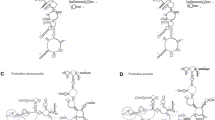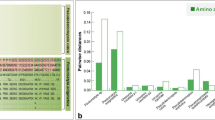Abstract
In order to reveal the structural evolutionary trend of Mobilida ciliates, twenty-six SSU-rRNA sequences of mobilid species, including seven ones newly sequenced in the present work, were used for comparative phylogenic analysis based on the RNA secondary structure. The research results indicate that all the secondary structures except domains Helix 10, Helix 12, and Helix 37 could be regarded as the criterions in classification between the family Trichodinidae and Urceolariida, and four regions including Helix E10-1, Helix 29, Helix 43, and Helix 45–Helix 46 could be as criterions in classification between the genus Trichodinella and Trichodina in family Trichodinidae. After the analysis of common structural feature within the Mobilida, it was found that the secondary structure of V6 could prove the family Urceolariidae primitive status. This research has further suggested that the genus Trichodina could be divergent earlier than Trichodinella in the family Trichodinidae. In addition, the relationship between the secondary structure and topology of phylogenic tree that the branching order of most clades corresponds with the secondary structure of species within each clade of phylogenetic tree was first uncovered and discussed in the present study.




Similar content being viewed by others
References
Astrid SH, Rod W, Christina S (2007) The secondary structure of the unusually long 18S ribosomal RNA of the myxozoan Sphaerospora truttae and structural evolutionary trends in the Myxozoa. Int J Parasitol 37:1281–1295
Clark CG (1987) On the evolution of ribosomal RNA. J Mol Evol 25:343–350
De Rijk P, Wuyts J, De Wachter R (2003) RnaViz 2: an improved representation of RNA secondary structure. Bioinformatics 19:299–300
Gong YC, Yu YH, Feng WS, Shen YF (2005) Phylogenetic relationships among Trichodinidae (Ciliophora: Peritricha) derived from the characteristic values of denticles. Acta Protozool 44:237–243
Gong YC, Yu YH, Villalobo E, Zhu FY, Feng WS (2006) Reevaluation of the phylogenetic relationship between mobiline and sessiline peritrichs (Ciliophora, Oligohymenophorea) based on sequences of 18S small subunit rRNA genes. J Eukaryot Microbiol 53:397–403
Gong YC, Yu YH (2007) Progress in the Taxonomy and Phylogeny of Trichodinids. Zool Res 28:217–224
Gonzalez P, Labarère J (2000) Phylogenetic relationships of Pleurotus species according to the sequence and secondary structure of the mitochondrial small-subunit rRNA V4, V6 and V9 domains. Microbiology 146:209–221
Hong SG, Jung HS (2004) Phylogenetic analysis of Ganoderma based on nearly complete mitochondrial small-subunit ribosomal DNA sequences. Mycologia 4:742–755
Liu CY, Zhang WY (2007) An attempt to use rRNA secondary structure characters in fungal systematics. Mycosystema 26:22–31
Liu Y, Cui XL, Li WJ, Peng Q (2006) Application of RNA secondary structure in phylogenetic analysis of microbiology. Microbiology 33:147–150
Mathews DH, Sabina J, Zuker M, Turner DH (1999) Expanded sequence dependence of thermodynamic parameters improves prediction of RNA secondary structure. J Mol Biol 288:911–940
Neefs JM, Van de Peer Y, De Rijk P, Chapelle S, De Wachter R (1993) Compilation of small subunit ribosomal subunit RNA structure. Nucleic Acids Res 13:3025–3049
Ronquist F, Huelsenbeck JP (2003) MrBayes 3: Bayesian phylogenetic inference under mixed models. Bioinformatics 19:1572–1574
Swofford D (2003) PAUP*: phylogenetic analysis using parsimony (* and other methods), version 4.0b10. Sinauer, Sunderland
Tang FH, Zhao YJ, Alan W (2013) Phylogenetic analyses of Trichodinids (Ciliophora, Oligohymenophora) inferred from 18S rRNA gene sequence data. Curr Microbiol 66:306–313
Thompson J, Gibson T, Plewniak F, Jeanmougin F, Higgins D (1997) The Clustal X windows interface: flexible strategies for multiple sequence alignment aided by quality analysis tools. Nucleic Acids Res 24:4876–4882
Van de Peer Y, De Rijk P, Wuyts J, Winkelmans T, De Wachter R (2000) The European small subunit ribosomal RNA database. Nucleic Acids Res 28:175–176
Wuyts J, De Rijk P, Van de Peer Y, de Wachter R (2001) Distribution of substitution rates and location of insertion sites in the tertiary structure of ribosomal RNA. Nucleic Acids Res 24:5017–5028
Wuyts J, De Rijk P, Van de Peer Y, Pison G, Rousseeuw P, De Wachter R (2000) Comparative analysis of more than 3000 sequences reveals the existence of two pseudoknots in area V4 of eukaryotic small subunit ribosomal RNA. Nucleic Acids Res 28:4698–4708
Wuyts J, Perrière G, Van de Peer Y (2004) The European ribosomal RNA database. Nucleic Acids Res 32:D101–D103
Zhan ZF, Xu KD, Micah D (2012) Evaluating molecular support for and against the monophyly of the Peritrichia and phylogenetic relationships within the Mobilida (Ciliophora, Oligohymenophorea). Zool Scr 42:213–226
Zuker M (2003) MFold web server for nucleic acid folding and hybridization prediction. Nucleic Acids Res 31:1–10
Zwieb C, Glotz C, Brimacombe R (1981) Secondary structure comparisons between small subunit ribosomal RNA molecules from six different species. Nucleic Acids Res 9:3621–3640
Acknowledgments
This present work was supported by grants from the National Natural Science Foundation of China (Nos. 31101637, 31172068, 31471980), projects of Chongqing Science and Technology Commission (Nos. cstc2010ca1010, cstc2014jcyjA80008), the Science Research Foundation of the Education Committee of Chongqing (No. KJ1400530).
Author information
Authors and Affiliations
Corresponding author
Rights and permissions
About this article
Cite this article
Zhang, Y., Zhao, YJ., Wang, Q. et al. New Comparative Analysis Based on the Secondary Structure of SSU-rRNA Gene Reveals the Evolutionary Trend and the Family-Genus Characters of Mobilida (Ciliophora, Peritrichia). Curr Microbiol 71, 259–267 (2015). https://doi.org/10.1007/s00284-015-0848-0
Received:
Accepted:
Published:
Issue Date:
DOI: https://doi.org/10.1007/s00284-015-0848-0




